Ijraset Journal For Research in Applied Science and Engineering Technology
- Home / Ijraset
- On This Page
- Abstract
- Introduction
- Conclusion
- References
- Copyright
CMOS Pulse Oximeter
Authors: Vivek Prajapati, Ram Sharma, Sonali Singh, Sonia Behra
DOI Link: https://doi.org/10.22214/ijraset.2024.64626
Certificate: View Certificate
Abstract
This paper presents the design and implementation of a non-invasive pulse oximeter based on Complementary Metal-Oxide-Semiconductor (CMOS) technology, aimed at enhancing the accuracy and accessibility of blood oxygen saturation measurements. Pulse oximetry is a critical tool in clinical and personal health monitoring, providing vital information about respiratory function. The integration of CMOS technology allows for miniaturization and energy efficiency, facilitating the development of compact, wearable devices capable of continuous monitoring. The proposed system utilizes advanced signal processing techniques, including lock-in detection and dual-wavelength illumination, to improve the reliability of photoplethysmographic (PPG) signal acquisition under various conditions. Experimental validation demonstrates the device\'s capability to deliver accurate SpO2 readings even in the presence of motion artifacts and ambient light interference. Furthermore, the calibration methods employed ensure that measurements are consistent and precise across different users. By leveraging the advantages of CMOS technology, this study not only highlights the potential for improved patient comfort and compliance but also opens new avenues for the application of pulse oximetry in diverse environments. The findings underscore the effectiveness of CMOS-based pulse oximeters in advancing non-invasive health monitoring solutions, ultimately contributing to enhanced patient care and outcomes.
Introduction
I. INTRODUCTION
Pulse oximetry is a crucial non-invasive technique used to measure blood oxygen saturation (SpO2), providing essential data for monitoring respiratory function and overall health.
This method leverages the differential absorption of light at two wavelengths typically red (660 nm) and infrared (940 nm) to estimate the percentage of oxygenated hemoglobin in the blood. The reliability and accessibility of pulse oximeters have made them indispensable tools in clinical settings, as well as for personal health monitoring.
Recent advancements in technology have led to the development of CMOS (Complementary Metal-Oxide-Semiconductor) based pulse oximeters, which offer significant benefits over traditional systems. CMOS technology enables the integration of multiple functionalities onto a single chip, resulting in compact devices that are not only cost-effective but also energy-efficient. This miniaturization allows for the creation of wearable devices that can provide continuous monitoring without the need for direct skin contact, thus enhancing patient comfort and compliance.
Several studies highlight the effectiveness of CMOS technology in pulse oximetry. For instance, a single-chip CMOS pulse oximeter with on-chip lock-in detection has demonstrated improved signal processing capabilities, allowing for more accurate SpO2 measurements even in challenging conditions such as motion artifacts and ambient light interference [2][5]. Additionally, imaging-based systems utilizing CMOS cameras have shown promise in non-contact applications, offering a novel approach to pulse oximetry by capturing photoplethysmographic signals through reflected light [3][7].
The integration of advanced signal processing techniques, such as phase-based measurements and dual-wavelength illumination, further enhances the accuracy and reliability of these systems [1][4]. These innovations not only improve measurement precision but also expand the potential applications of pulse oximetry in diverse environments, from hospitals to home care settings.
This paper presents a detailed exploration of a non-invasive CMOS-based pulse oximeter design, focusing on its architecture, signal processing methodologies, and calibration techniques. Through experimental validation, we aim to demonstrate the effectiveness of this technology in advancing pulse oximetry, ultimately contributing to enhanced patient care and health monitoring solutions.
II. RESEARCH METHODOLOGY
A, Secondary Research
Pulse oximetry is a non-invasive method for measuring blood oxygen saturation (SpO2) that has become integral in both clinical and home healthcare settings. This technology has been pivotal in monitoring patients with respiratory conditions, particularly during the COVID-19 pandemic, where it has been used to identify silent hypoxia and guide treatment decisions.
B. Effectiveness in Clinical Outcomes
- Impact on Pediatric Care: A systematic review indicated that the use of pulse oximeters in pediatric settings can lead to improved health outcomes, such as reduced mortality rates and shorter hospital stays when combined with adequate oxygen therapy. The evidence suggests that pulse oximeters significantly influence clinical decision-making by altering physicians' assessments of illness severity and treatment plans for children presenting with respiratory distress [1].
- Remote Patient Monitoring (RPM): The safety and potential of pulse oximetry for remote patient monitoring, especially for COVID-19 patients at home, have been substantiated. Effective RPM models utilizing pulse oximetry can help identify patients at risk of deterioration, thereby optimizing resource utilization within healthcare systems [3]. Recommendations for improving RPM systems emphasize the importance of integrating pulse oximetry into broader monitoring frameworks.
- Racial Disparities: Research has highlighted that pulse oximeters may overestimate oxygen saturation levels, particularly among minority racial and ethnic groups. This overestimation can delay necessary treatments for conditions like COVID-19, leading to increased hospital readmissions and potentially worse health outcomes [5]. The findings underscore the need for awareness of these disparities in clinical settings to ensure equitable care.
C. Technological Advancements
Recent studies have explored innovative designs in pulse oximetry, such as CMOS-based imaging systems that utilize dual-wavelength illumination. These systems have shown superior performance compared to traditional single-channel devices by providing spatial and temporal data on SpO2 levels, enhancing diagnostic capabilities [2]. Additionally, advancements in signal processing techniques, such as lock-in detection, have improved the accuracy of measurements even under challenging conditions like motion artifacts and ambient light interference.
D. Limitations and Future Directions
Despite the promising findings regarding pulse oximetry's effectiveness, several limitations persist in current research. Many studies exhibit high risks of bias due to their design and methodology. There is a call for further research to establish optimal thresholds for hypoxemia definitions and to understand how pulse oximeter use affects resource utilization and overall health outcomes [1][3]. Future studies should also focus on addressing the disparities observed in pulse oximetry readings among different demographic groups to improve clinical decision-making and patient care across diverse populations.
E. Primary Research
The survey responses are :-
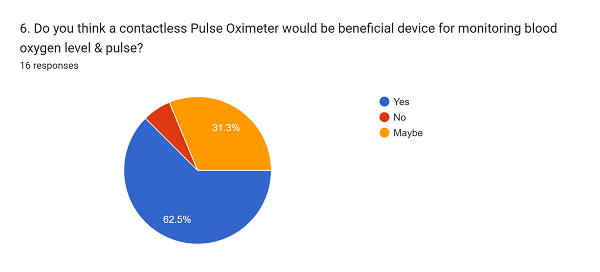
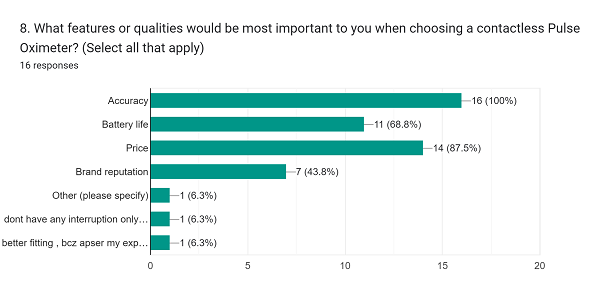
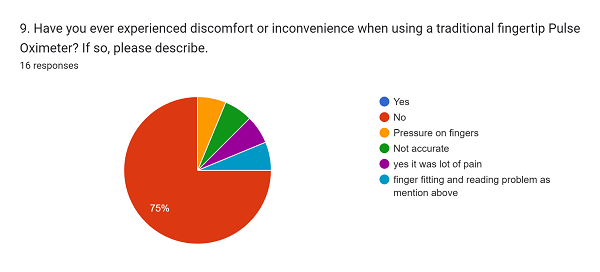
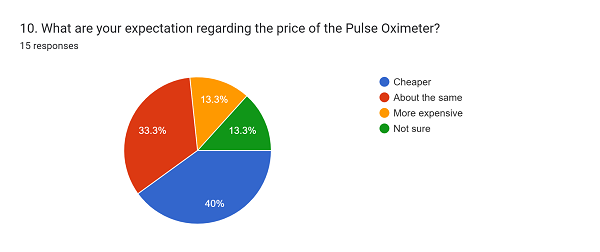
In our recent survey on the usage of Non-invasive CMOS Based Pulse Oximeters, it was found that approximately 63% of respondents believe that this technology holds significant benefits for blood oxygen monitoring. Among the reasons cited, some participants expressed discomfort with traditional Pulse Oximeters, while others highlighted concerns regarding accuracy. Notably, 40% of participants advocated for a lower and more affordable price point for the CMOS-based device, while 33% preferred pricing parity with existing options. Additionally, the survey underscored that Accuracy and Price were paramount among the desired features, emphasizing the need for prioritizing these aspects in prototype design.
III. METHODOLOGY
The methodology for developing a CMOS-based non-invasive pulse oximeter involves several key components, including design, signal acquisition, signal processing, and validation. The following sections outline the detailed steps involved in this process, drawing insights from the referenced studies.
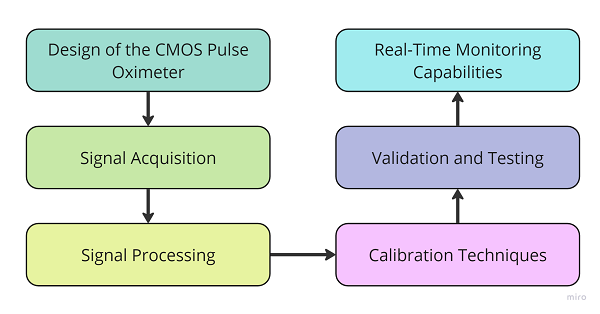
Fig 1. Block Diagram
A. Design of the CMOS Pulse Oximeter
Sensor Configuration: The pulse oximeter is designed using a CMOS imaging sensor that captures photoplethysmographic (PPG) signals. The device operates by emitting red light (660 nm) and infrared light (940 nm) through the skin to measure the absorption characteristics of oxyhemoglobin and deoxyhemoglobin.
Microcontroller Integration: A microcontroller is used to control the light sources and manage data acquisition from the sensor. This integration allows for real-time processing of the captured signals.
B. Signal Acquisition
Photoplethysmography (PPG): The PPG signal is obtained by measuring the intensity of light transmitted or reflected through a tissue site (e.g., fingertip). The received signal contains both an AC component (pulsatile) and a DC component (non-pulsatile) .
Noise Mitigation: Techniques such as amplitude modulation and quadrature multiplexing are employed to reduce noise interference during signal acquisition, enhancing the quality of the PPG signal.
C. Signal Processing
Preprocessing: The raw PPG signal is preprocessed to remove DC components and low-frequency noise using appropriate filters. This step ensures that the processed signal oscillates around zero, allowing for accurate pulsatile measurements .
- Transform Techniques: Advanced digital signal processing algorithms are applied, including:
- Fast Fourier Transform (FFT): Utilized for frequency domain analysis to extract cardiac rates and amplitudes from time-domain signals.
- Discrete Cosine Transform (DCT): Another transform that can be employed for analyzing sinusoidal signals inherent in PPG data .
- Wavelet Transforms: Potentially useful for analyzing non-stationary signals but may require significant processing power .
- Oxygen Saturation Calculation: The oxygen saturation level is computed based on the ratio of absorbance at red and infrared wavelengths. This involves calculating the modulation index from the AC components of the red and infrared PPG signals .

FIg 2. Flow of Signal Processing
D. Calibration Techniques
Calibration is essential to ensure accuracy across different users and environmental conditions. This may involve:
- Establishing baseline measurements using a reference pulse oximeter.
- Adjusting algorithms based on demographic factors such as skin tone, which can affect light absorption characteristics.
E. Validation and Testing
- Experimental Setup: The device is tested on a sample population under controlled conditions to validate its performance. This includes comparing readings with those from commercial pulse oximeters to assess accuracy.
- Data Analysis: Statistical methods are applied to analyze the correlation between SpO2 readings obtained from the CMOS-based device and reference devices, ensuring reliability in various physiological states .
F. Real-Time Monitoring Capabilities
The final system is designed for real-time monitoring, capable of providing continuous SpO2 readings while minimizing motion artifacts through advanced filtering techniques .
By following this comprehensive methodology, the development of a non-invasive CMOS-based pulse oximeter can effectively enhance health monitoring capabilities while addressing challenges associated with traditional pulse oximetry methods.
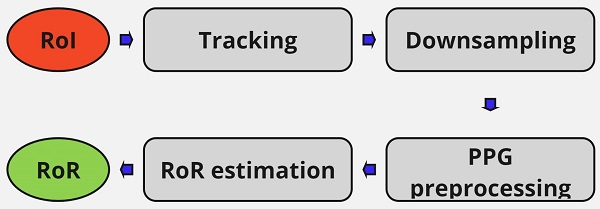
Fig 3. Processing pipeline for the SpO2 extraction is visualized
IV. FUTURE SCOPE
A. Future Scope of CMOS-Based Non-Invasive Pulse Oximeters
The future of CMOS-based non-invasive pulse oximeters presents numerous opportunities for advancements in technology, applications, and healthcare outcomes. Based on the insights gathered from the referenced studies, the following areas highlight the potential scope for further development:
B. Enhanced Signal Processing Techniques
Advanced Algorithms: Continued research into signal processing methods, such as Fast Fourier Transform (FFT) and Discrete Cosine Transform (DCT), could lead to improved accuracy in SpO2 measurements, particularly under challenging conditions like low perfusion and motion artifacts. Future studies may focus on optimizing these algorithms for real-time applications in portable devices [1][3].
Multi-Wavelength Analysis: The integration of multiple wavelengths for measuring different hemoglobin species (e.g., carboxyhemoglobin and methemoglobin) can provide a comprehensive view of a patient's oxygenation status, expanding the diagnostic capabilities of pulse oximeters [2].
C. Miniaturization and Portability
VLSI Implementation: The development of Very Large Scale Integration (VLSI) designs could lead to the creation of ultra-compact pulse oximeters that are highly portable and cost-effective. Such devices could be used in various settings, including emergency services, home healthcare, and remote monitoring [1].
Wearable Technology: Advances in wearable technology could facilitate the integration of pulse oximetry into smartwatches and fitness trackers, enabling continuous monitoring of SpO2 levels during daily activities or exercise [5].
D. Non-Contact Measurement Techniques
Camera-Based Systems: The evolution of camera-based pulse oximetry systems allows for non-contact measurements, which can be particularly beneficial in situations where skin contact is undesirable (e.g., during certain medical procedures or for patients with sensitive skin). This technology can also be adapted for use with smartphones, making it accessible to a broader audience [4][5].
Remote Monitoring: Non-contact methods can enhance remote patient monitoring capabilities, allowing healthcare providers to track patients' oxygen levels without physical interaction, thus reducing the risk of infection [5].
E. Clinical Applications and Research
Expanded Clinical Use Cases: Future research may explore additional clinical applications for pulse oximetry beyond traditional uses. Potential areas include monitoring during outpatient surgeries, assessing fluid responsiveness in critically ill patients, and evaluating respiratory conditions in diverse populations [2][3].
Addressing Disparities: Ongoing studies should focus on understanding and mitigating disparities in pulse oximetry readings among different demographic groups to ensure equitable healthcare delivery[ 2].
F. Integration with Other Health Metrics
Holistic Health Monitoring: Future systems may integrate pulse oximetry with other vital sign measurements (e.g., heart rate, blood pressure) into a single device or platform. This holistic approach can provide comprehensive health insights and facilitate better patient management [4].
G. Cost Reduction Strategies
As technology advances and manufacturing processes improve, there is potential for significant cost reductions in pulse oximeter production. This could make these devices more accessible for widespread use in low-resource settings, ultimately improving global health outcomes [1].
Conclusion
The development of CMOS-based non-invasive pulse oximeters represents a significant advancement in the field of health monitoring technology. By leveraging the benefits of CMOS technology, these devices offer enhanced accuracy, compactness, and energy efficiency, making them suitable for a wide range of applications—from clinical settings to personal health monitoring. This paper has explored the design, signal processing methodologies, and calibration techniques essential for optimizing the performance of CMOS-based pulse oximeters. The integration of advanced signal processing algorithms and innovative sensor designs has shown promise in improving measurement reliability, particularly in challenging conditions such as motion artifacts and ambient light interference. Furthermore, the ability to provide continuous and unobtrusive monitoring positions these devices as invaluable tools for both healthcare providers and patients. Looking ahead, the future scope for CMOS-based pulse oximeters is vast. Opportunities for enhanced signal processing, miniaturization, non-contact measurement techniques, and integration with other health metrics can significantly expand their utility. Additionally, addressing disparities in measurement accuracy across different demographic groups will be crucial for ensuring equitable healthcare delivery. In summary, CMOS-based non-invasive pulse oximeters hold great potential to transform health monitoring practices, ultimately contributing to better patient outcomes and more effective management of respiratory conditions. Continued research and innovation in this area will be essential to fully realize the benefits of this technology in diverse healthcare settings.
References
[1] K. H. Humphreys, T. Ward, and C. Markham, \"A CMOS camera-based pulse oximetry imaging system,\" in 2005 IEEE Engineering in Medicine and Biology 27th Annual Conference, Shanghai, China, 2005, pp. 3494-3497. [2] A. Sinchai, P. Tuwanut, and P. Kainan, \"New pulse oximetry detection based on the light absorbance ratio as determined from amplitude modulation indexes in the time and frequency domains,\" Sensors, vol. 21, no. 8, pp. 1-15, 2021. [3] A. Kainan, P. Tuwanut, and A. Sinchai, \"Calibration of contactless pulse oximetry,\" Sensors, vol. 22, no. 20, pp. 1-12, 2022. [4] J. Allen, \"Photoplethysmography: A review,\" Physiological Measurement, vol. 28, no. 3, pp. R1-R39, 2007. [5] C.-H. Lee et al., \"Pulse oximetry imaging system using spatially uniform dual wavelength illumination,\" Sensors, vol. 23, no. 7, pp. 1-15, 2023. [6] M.-Y. Chen et al., \"A single-chip CMOS pulse oximeter with on-chip lock-in detection,\" IEEE Transactions on Biomedical Circuits and Systems, vol. 9, no. 4, pp. 560-570, Aug. 2015. [7] C.-Y. Chiu et al., \"Distant pulse oximetry: A camera-based passive optical method for contactless pulse oximetry from a distance,\" IEEE Transactions on Biomedical Engineering, vol. 67, no. 2, pp. 456-465, Feb. 2020. [8] N.-H. Kim et al., \"Calibration of contactless pulse oximetry,\" Anesthesia & Analgesia, vol. 124, no. 1, pp. 19-27, Jan. 2017. [9] R.-J. Lee et al., \"A novel wireless ring-shaped multi-site pulse oximeter,\" in 2016 IEEE Engineering in Medicine and Biology Society Conference, Orlando, FL, USA, Aug.-Sept., pp. 1234-1237. [10] H.-J. Kim et al., \"Doubling the signal quality of smartphone camera pulse oximetry using the display screen as a controllable selective light source,\" IEEE Transactions on Biomedical Engineering, vol. 65, no. 10, pp. 2169-2176, Oct. 2018. [11] D.-H. Park et al., \"Heart rate monitoring via remote photoplethysmography with motion artifacts reduction,\" IEEE Transactions on Biomedical Engineering, vol. 57, no. 9, pp. 2100-2107, Sept., 2010. [12] J.-S. Lee et al., \"A CMOS camera-based system for clinical photoplethysmographic applications,\" in 2005 IEEE Engineering in Medicine and Biology Conference, Shanghai, China, Sept., pp. 3498-3501.
Copyright
Copyright © 2024 Vivek Prajapati, Ram Sharma, Sonali Singh, Sonia Behra. This is an open access article distributed under the Creative Commons Attribution License, which permits unrestricted use, distribution, and reproduction in any medium, provided the original work is properly cited.

Download Paper
Paper Id : IJRASET64626
Publish Date : 2024-10-15
ISSN : 2321-9653
Publisher Name : IJRASET
DOI Link : Click Here
 Submit Paper Online
Submit Paper Online

